

Audio Ear Training Online. MJ101. Harmony. Barbershop quartets, such as this US Navy group, sing 4-part pieces, made up of a melody line (normally the lead) and 3 harmony parts.
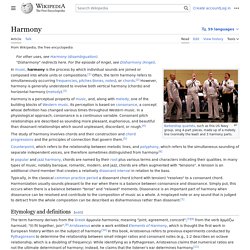
Etymology and definitions[edit] The term harmony derives from the Greek ἁρμονία (harmonía), meaning "joint, agreement, concord",[4] from the verb ἁρμόζω (harmozo), "to fit together, to join".[5] The term was often used for the whole field of music, while "music" referred to the arts in general. Counterpoint. General principles[edit] It is hard to write a beautiful song.

It is harder to write several individually beautiful songs that, when sung simultaneously, sound as a more beautiful polyphonic whole. List of Romantic-era composers. This is a list of Romantic-era composers.
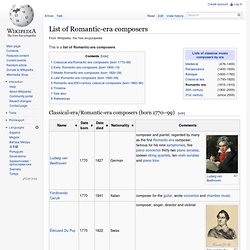
Classical-era/Romantic-era composers (born 1770–99)[edit] Repertoire key: B=In Classical Net's basic Timeline of Major Composers 1600–present[1] Early Romantic-era composers (born 1800–19)[edit] Romanticism. Defining Romanticism[edit] Basic characteristics[edit] The nature of Romanticism may be approached from the primary importance of the free expression of the feelings of the artist.
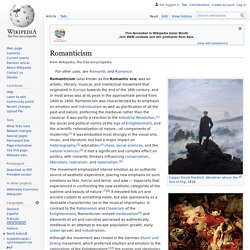
The importance the Romantics placed on emotion is summed up in the remark of the German painter Caspar David Friedrich, "the artist's feeling is his law".[10] For William Wordsworth, poetry should begin as "the spontaneous overflow of powerful feelings", which the poet then "recollect[s] in tranquility", evoking a new but corresponding emotion the poet can then mold into art.[11] 21 Brilliant Camping Hacks. Jazz Endings: Common Ways to Come to a Conclusion. Jazz Endings: Common Ways to Come to a Conclusion. 10 Jazz Guitar Endings. Questions, remarks or other feedback about this tutorial, discuss it in the Jazz Guitar Forum.

There are so many ways to end a song, here are 10 of them. Use them as a starting point to develop your own endings. Click Here To Download Your Free Jazz Guitar eBook 1) Major 6/9/#11 Chords. Hermeto Pascoal. Hermeto Pascoal. Modes of limited transposition. Technical criteria[edit] Based on our present chromatic system, a tempered system of 12 sounds, these modes are formed of several symmetrical groups, the last note of each group always being common with the first of the following group.
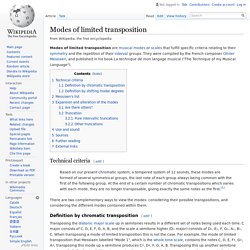
At the end of a certain number of chromatic transpositions which varies with each mode, they are no longer transposable, giving exactly the same notes as the first.[1] There are two complementary ways to view the modes: considering their possible transpositions, and considering the different modes contained within them. Transcribing. Imagine that you’ve just stepped off a plane in a foreign country… You grab your suitcase and step onto the soil for the first time and suddenly you’re filled with a sense of excitement and anticipation.

What new sights, new sounds, unusual food, and interesting people await you in this strange new place? Your mind races with possibilities and you can barely wait to get out there and start exploring. But after a few days you begin to notice something odd… At each stop on your journey everyday conversation seems to elude you. Altered Dominant Chord in Jazz Improvisation. Alterations are at the heart of jazz… In no other genre of music can you freely alter chords in a such a fluid and flexible manner.
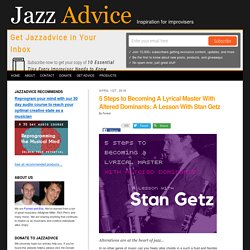
As chords whiz by, the soloist has the freedom to add all sorts of chord alterations to their melodic lines. But it requires a sense of how these altered chord tones behave and a certain kind of know-how to use them effectively. The best place to start experimenting with alterations is over the dominant chord because that’s where you have the most options. But, if you’ve ever tried to alter a dominant chord before, you know that it’s not that easy. Here’s the situation… You’re about to play over a dominant chord. . … and your thought process might go something like this… Your initial reaction? “What scale am I going to play if I want to alter the dominant chord?” So now that you have your scale choices, you think you’re all good. What are professionals doing that makes their use of alterations sound so good and how can I do it too?
Well, not so much… "Transitions" - Parvaaz live at Jagriti Theatre. The Science of Sample Rates (When Higher Is Better — And When It Isn’t) Image courtesy of Flickr user mikecogh One of the most hotly—and perhaps unnecessarily—debated topics in the world of audio is the one that surrounds digital sample rates.

It seems an unlikely topic for polarization, but for more than 10 years, the same tired arguments have been batted about by each side with almost unrelenting intensity. BBC Howard Goodall's Story of Music 1of6 The Age of Discovery. The Tragedy of A Relationship. In August 2000, Ravi Shankar’s first wife, the reclusive surbahar virtuoso Annapurna Devi, did her only interview in 60 years with me in which she spoke about her torturous marriage and the tragic life of their son Shubho.
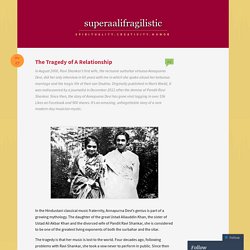
Originally published in Man’s World, it was rediscovered by a journalist in December 2012 after the demise of Pandit Ravi Shankar. Since then, the story of Annapurna Devi has gone viral logging in over 10k Likes on Facebook and 900 shares. It’s an amazing, unforgettable story of a rare modern-day musician mystic. Partitions gratuites. Real Book - Volume 1, 2, 3(C, Eb, Bb) A Child is Born (Thad Jones) Affirmation (José Feliciano) A Foggy Day (George Gershwin) Afro Blue (Mongo Santamaria)
WhyStudyHarmony TedGreene 1974 09 01. MICHAEL MIZRAHI.